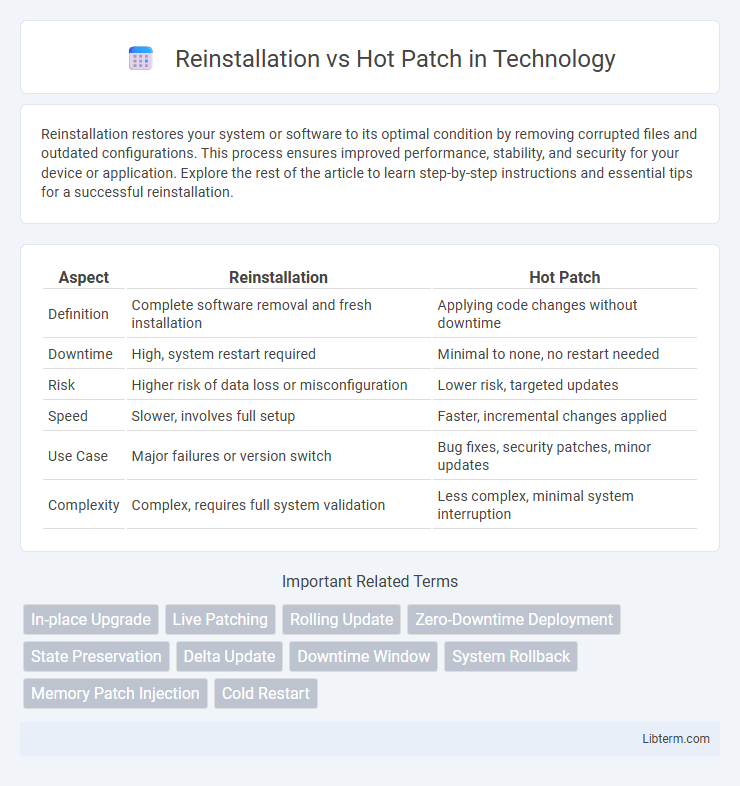Reinstallation restores your system or software to its optimal condition by removing corrupted files and outdated configurations. This process ensures improved performance, stability, and security for your device or application. Explore the rest of the article to learn step-by-step instructions and essential tips for a successful reinstallation.
Table of Comparison
| Aspect | Reinstallation | Hot Patch |
|---|---|---|
| Definition | Complete software removal and fresh installation | Applying code changes without downtime |
| Downtime | High, system restart required | Minimal to none, no restart needed |
| Risk | Higher risk of data loss or misconfiguration | Lower risk, targeted updates |
| Speed | Slower, involves full setup | Faster, incremental changes applied |
| Use Case | Major failures or version switch | Bug fixes, security patches, minor updates |
| Complexity | Complex, requires full system validation | Less complex, minimal system interruption |
Introduction: Understanding Reinstallation and Hot Patch
Reinstallation involves completely removing and then reinstalling software to restore system functionality or apply updates, ensuring a clean and stable environment. Hot patching modifies a running program's code without stopping its execution, allowing immediate updates and fixes with minimal downtime. Understanding the differences between these methods is crucial for selecting the appropriate approach in system maintenance and software management.
Definitions: What is Reinstallation?
Reinstallation refers to the process of completely removing and then installing software or an operating system anew to restore functionality, resolve issues, or upgrade components. This method typically involves overwriting existing files, settings, and configurations, which can lead to data loss if not properly backed up. Reinstallation is often used as a last resort when software corruption or compatibility problems cannot be fixed through incremental updates or patches.
Definitions: What is a Hot Patch?
A hot patch is a software update applied directly to a running system without requiring a restart or downtime, enabling immediate fixes or improvements. Unlike reinstallation, which involves removing and reinstalling the entire software package, hot patching modifies specific code segments dynamically to address vulnerabilities or bugs. This approach minimizes disruption and ensures continuous system availability while maintaining security and stability.
Core Differences Between Reinstallation and Hot Patch
Reinstallation involves completely removing and then installing software or an operating system to restore functionality or upgrade versions, often requiring significant downtime. Hot patching applies updates or fixes to running software without restarting or stopping the system, minimizing downtime and allowing continuous operation. The core difference lies in downtime impact and process complexity: reinstallation is disruptive but thorough, while hot patching is seamless but typically limited to specific types of updates.
Pros and Cons of Reinstallation
Reinstallation offers a clean slate by completely removing old files and configurations, ensuring system stability and eliminating lingering bugs or corrupted data. However, it requires significant downtime, increased labor, and the risk of data loss if backups are not properly maintained. This method is preferable for major system overhauls or when hot patching cannot resolve persistent issues effectively.
Pros and Cons of Hot Patch
Hot patching allows software updates without system downtime, improving operational continuity and user productivity. It reduces risks associated with full system reinstallation, such as data loss and lengthy configuration processes. However, hot patching can introduce stability issues if patches are not thoroughly tested, and may have limited applicability depending on the complexity of the changes required.
Use Cases: When to Choose Reinstallation
Reinstallation is ideal for scenarios requiring a clean slate, such as fixing corrupted system files, removing persistent malware, or resolving deep configuration errors that cannot be undone by patches. This method ensures all existing software components are reset to their original state, beneficial when system stability is compromised beyond incremental fixes. It is especially useful in enterprise environments where compliance and security standards demand a full system refresh to prevent vulnerabilities.
Use Cases: When to Apply a Hot Patch
Hot patches are essential for applying critical security fixes and urgent bug resolutions without restarting or disrupting system operations, making them ideal for production environments requiring high availability. Reinstallation is reserved for extensive updates, major version changes, or when system integrity is compromised beyond repair. Hot patching is preferred in use cases where downtime must be minimized, such as live servers, financial systems, and cloud infrastructures.
Impact on System Downtime and Performance
Reinstallation typically results in significant system downtime due to the need for complete shutdown, data backup, and full software setup, impacting productivity. Hot patching minimizes downtime by applying updates directly to running systems without requiring restarts, thus maintaining continuous performance. However, hot patches may temporarily consume more system resources during application, potentially causing slight performance degradation compared to a fresh reinstallation.
Best Practices for Software Maintenance Decisions
Choosing between reinstallation and hot patching depends on factors like system uptime requirements, patch complexity, and risk tolerance; hot patches are ideal for critical security fixes requiring minimal downtime, while reinstallations ensure comprehensive updates at the cost of longer downtime. Best practices for software maintenance emphasize thorough testing of hot patches in staging environments to prevent system instability and maintaining detailed rollback procedures to quickly recover from faulty patches. Documentation of patch history and version control supports informed decision-making and compliance with IT governance standards.
Reinstallation Infographic

 libterm.com
libterm.com